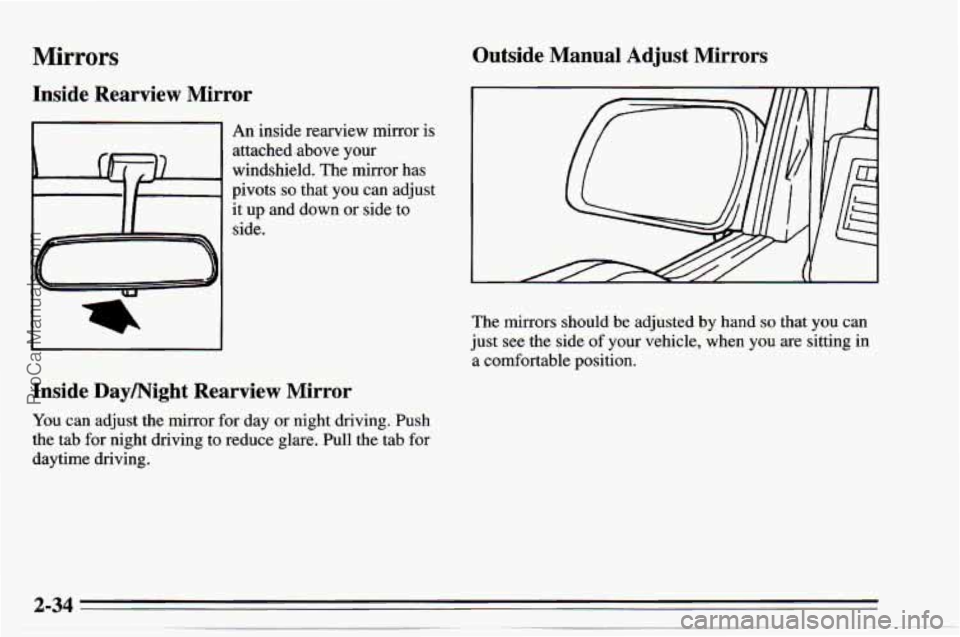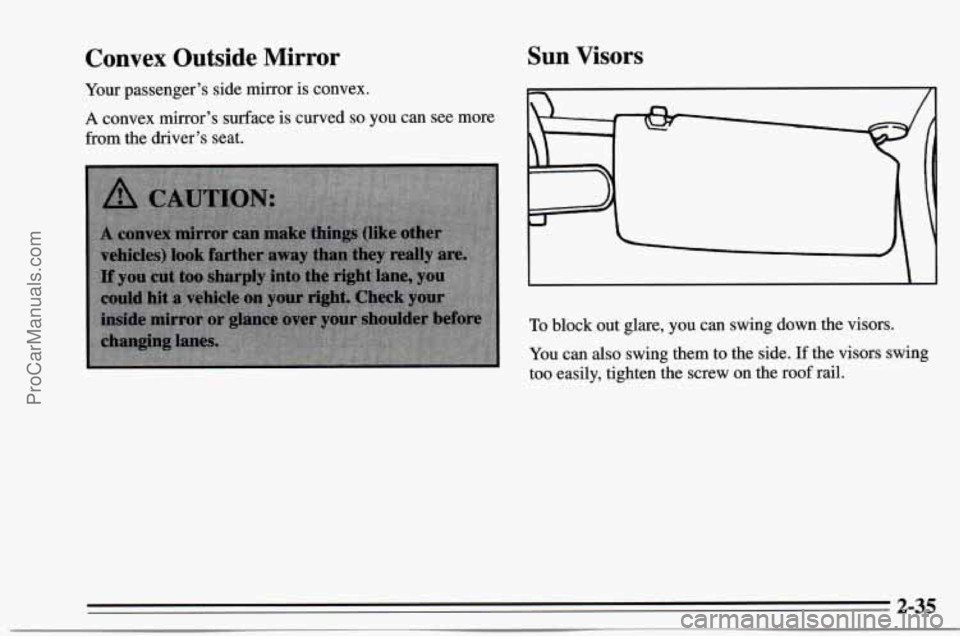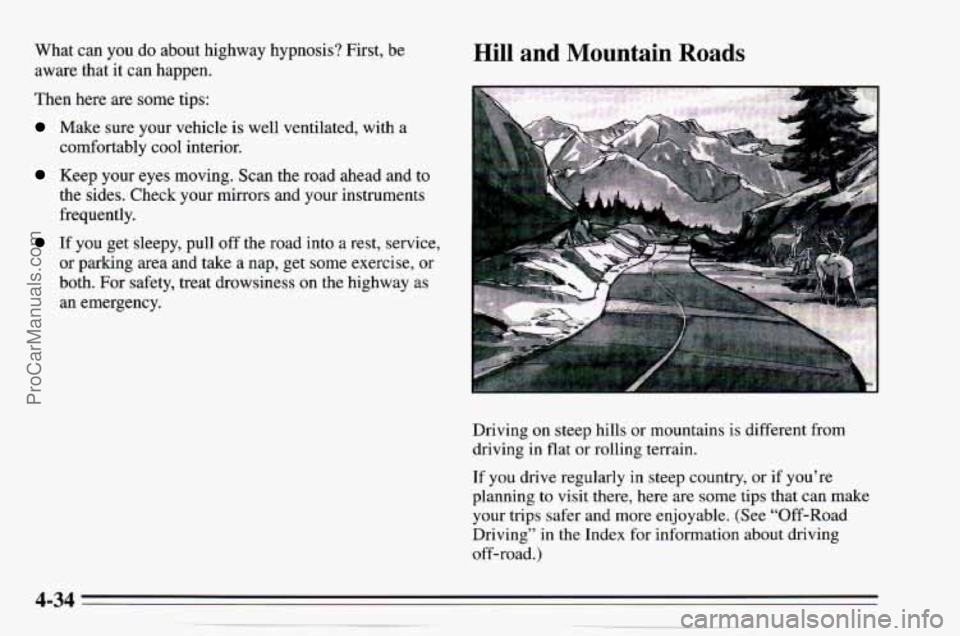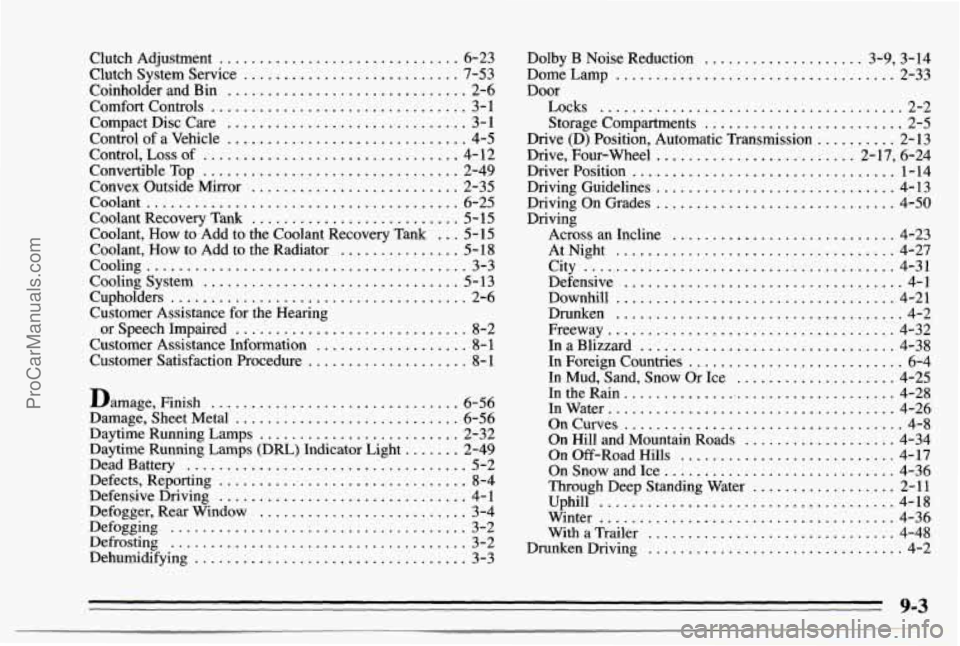mirror CHEVROLET TRACKER 1995 Owners Manual
[x] Cancel search | Manufacturer: CHEVROLET, Model Year: 1995, Model line: TRACKER, Model: CHEVROLET TRACKER 1995Pages: 354, PDF Size: 18.24 MB
Page 77 of 354

Mirrors
Inside Rearview Mirror
An inside rearview mirror is
attached .above your
windshield. The mirror has
pivots
so that you can adjust
it up and down or side to
side.
Inside Daymight Rearview Mirror
You can adjust the mirror for day or night driving. Push
the tab for night driving to reduce glare. Pull the tab
for
daytime driving.
Outside Manual Adjust Mirrors
The mirrors should be adjusted by hand so that you can
just see the side
of your vehicle, when you are sitting in
a comfortable position.
ProCarManuals.com
Page 78 of 354

Convex Outside Mirror Sun Visors
Your passenger’s side mirror is convex.
A convex mirror’s surface is curved so you can see more
from the driver’s seat.
To block out glare, you can swing down the visors.
You can also swing them
to the side. If the visors swing
too easily, tighten the screw
on the roof rail.
2-35
ProCarManuals.com
Page 137 of 354

Check your mirrors, glance over your shoulder, and
start your left lane change signal before moving out
of the right lane to pass. When you are far enough
ahead
of the passed vehicle to see its front in your
inside mirror, activate your right lane change signal
and move back into the right lane. (Remember that
your right outside mirror is convex. The vehicle
you
just passed may seem to be farther away from you
than it really is.)
Try not to pass more than one vehicle at a time on
two-lane roads. Reconsider before passing the
next
vehicle.
0 Don’t overtake a slowly moving vehicle too rapidly.
Even though the brake lamps are not flashing, it may
be slowing down
or starting to turn.
following driver to get ahead
of you. Perhaps you
can ease a little to the right.
If you’re being passed, make it easy for the
Loss of Control
Let’s review what driving experts say about what
happens when the three control systems (brakes, steering
and acceleration) don’t have enough friction where the
tires meet the road to do what the driver has asked.
In any emergency, don’t give up. Keep trying to steer
and constantly seek an escape route or area
of less
danger.
Skidding
In a skid, a driver can lose control of the vehicle.
Defensive drivers avoid most skids by taking reasonable
care suited to existing conditions, and by not
“overdriving” those conditions. But skids are always
possible.
The three types
of skids correspond to your Geo’s three
control systems. In the braking skid your wheels aren’t
rolling. In the steering or cornering skid, too much speed
or steering in a curve causes tires to slip
and lose
cornering force. And in the acceleration skid too much
throttle causes the driving wheels to spin.
A cornering skid and an acceleration skid are best
handled by easing your foot off the accelerator pedal.
ProCarManuals.com
Page 138 of 354

If your vehicle starts to slide, ease your foot off the
accelerator pedal and quickly steer the way you want the
vehicle to go. If you start steering quickly enough, your
vehicle may straighten
out. Always be ready for a
second skid if it occurs.
Of course, traction is reduced when water, snow, ice,
gravel, or other material is on the road. For safety,
you’ll
want to slow down and adjust your driving to these
conditions. It is important to slow down on slippery
surfaces because stopping distance will be longer and
vehicle control more limited.
While driving
on a surface with reduced traction, try
your best to avoid sudden steering, acceleration, or
braking (including engine braking by shifting to a lower
gear). Any sudden changes could cause the tires to slide.
You may not realize the surface
is slippery until your
vehicle is skidding. Learn
to recognize warning
clues
-- such as enough water, ice or packed snow on
the road to make a “mirrored surface” -- and slow
down when you have any doubt.
Remember: The rear-wheel anti-lock braking system
(RWAL) helps avoid only a rear braking skid.
In a
braking skid (where the front wheels are no longer
rolling), release enough pressure
on the brakes to get the front
wheels rolling again. This restores steering control.
Push the brake pedal down steadily when you have to
stop suddenly. As long as the front wheels are rolling,
you will have steering control.
Driving Guidelines
This multipurpose passenger vehicle is defined as a
utility vehicle
in Consumer Information Regulations
issued by the National Highway Traffic Safety
Administration (NHTSA) of the United States
Department of Transportation, Utility vehicles have
higher ground clearance and a narrower track to make
them capable of performing in a wide variety
of off-road
applications. Specific design characteristics give them
a
higher center of gravity than ordinary cars. An
advantage
of the higher ground clearance is a better
view
of the road allowing you to anticipate problems.
They are
not designed for cornering at the same speeds
as conventional 2-wheel drive vehicles any more than
low-slung sports cars are designed
to perform
satisfactorily under off-road conditions. If at all
possible, avoid sharp turns or abrupt maneuvers.
As with
other vehicles of this type, failure
to operate this vehicle
correctly may result in loss of control or vehicle
rollover.
ProCarManuals.com
Page 152 of 354

Driving at Night
Night driving is more dangerous than day driving.
One reason is that some drivers are likely to be
impaired
-- by alcohol or drugs, with night vision
problems, or by fatigue.
Here
are some tips on night driving.
0 Drive defensively.
Don’t drink and drive.
0
a
a
0
Adjust your inside rearview mirror to reduce the
glare from headlamps behind
you.
Since you can’t see as well, you may need to slow
down and keep more space between you and other
vehicles.
Slow down, especially
on higher speed roads. Your
headlamps can light up
only so much road ahead.
In remote areas, watch for animals.
If you’re tired, pull off the road in a safe place and
rest.
Night Vision
No one can see as well at night as in the daytime. But as
we get older these differences increase. A 50-year-old
driver may require at least twice as much light to see the
same thing at night as a 20-year-old.
What you do
in the daytime can also affect your night
vision. For example, if
you spend the day in bright
sunshine you are wise to wear sunglasses. Your eyes will
have less trouble adjusting
to night. But if you’re
driving, don’t wear sunglasses at night. They may cut
down on glare from headlamps, but they also make a lot
of things invisible.
ProCarManuals.com
Page 157 of 354

Freeway Driving
Mile for mile, freeways (also called thruways, parkways,
expressways, turnpikes, or superhighways) are the safest
of all roads. But they have their own special rules. At the
entrance there is usually
a ramp that leads to the
freeway. If you have a clear view of the freeway as you
drive along the entrance ramp, you should begin
to
check traffic. Try to determine where you expect to
blend with the flow. Try to merge into the gap at close to
the prevailing speed. Switch
on your turn signal, check
your mirrors and glance over your shoulder as often as
necessary. Try to blend smoothly with the traffic
flow.
Once you are on the freeway, adjust your speed to the
posted limit or
to the prevailing rate if it's slower. Stay
in the right lane unless you want to pass.
Before changing lanes, check your mirrors. Then
use
your turn signal.
Just before
you leave the lane, glance quickly over your
shoulder to make sure there isn't another vehicle in your
"blind" spot.
Once you are moving on the freeway, make certain you
allow a reasonable following distance. Expect
to move
slightly slower at night.
When
you want to leave the freeway, move to the proper
lane well in advance. If you
miss your exit do not, under
any circumstances, stop and back up. Drive on to the
next exit.
The
most important advice on freeway driving is: Keep
up with traffic and keep to the right. Drive at the same
speed most
of the other drivers are driving. Too-fast or
too-slow driving breaks
a smooth traffic flow. Treat the
left lane on a freeway as a passing lane.
4-32
~----------- ~... .- - . - "_-_____ -_I-___ . .. ProCarManuals.com
Page 159 of 354

What can you do about highway hypnosis? First, be
aware that it can happen.
Then here are some tips:
Make sure your vehicle is well ventilated, with a
comfortably cool interior.
Keep your eyes moving. Scan the road ahead and to
the sides. Check your mirrors and your instruments
frequently.
If you get sleepy, pull off the road into a rest, service,
or parking area and take a nap, get some exercise, or
both. For safety, treat drowsiness
on the highway as
an emergency.
Hill and Mountain Roads
Driving on steep hills or mountains is different from
driving in flat or rolling terrain.
If you drive regularly in steep country, or if you’re
planning to visit there, here are some
tips that can make
your trips safer and more enjoyable. (See “Off-Road
Driving” in the Index for information about driving
off-road.)
ProCarManuals.com
Page 173 of 354

nailer Brakes
If your trailer weighs more than 1,000 pounds (450 kg)
loaded, then it needs its own brakes -- and they must be
adequate. Be sure to read and follow the instructions for
the trailer brakes
so you’ll be able to install, adjust and
maintain them properly.
Driving with a Trailer
0
0
0
Don’t tap into your vehicle’s brake system if the
trailer’s brake system will use more than
0.02 cubic
inch
(0.3 cc) of fluid from your vehicle’s master
cylinder.
If it does, both systems won’t work well.
You could even lose your brakes.
Will the trailer brake parts take
3,000 psi
(20 650 kPa) of pressure? If not, the trailer brake
system must not be used with your vehicle.
If everything checks out this far, then make the brake
fluid tap at the port on the master cylinder that sends
fluid to the rear brakes. But don’t use copper tubing
for this.
If you do, it will bend and finally break off.
Use steel brake tubing. Towing
a trailer requires a certain amount of experience.
Before setting out for the open road, you’ll
want to get
to know your rig. Acquaint yourself with the feel of
handling and braking with the added weight
of the
trailer. And always keep in mind that the vehicle you
are
driving is now a good deal longer and not nearly as
responsive as your vehicle
is by itself.
Before you start, check the trailer hitch and platform
(and attachments), safety chains, electrical connector,
lamps, tires and mirror adjustment.
If the trailer has
electric brakes, start your vehicle and trailer moving and
then apply the trailer brake controller by hand to be sure
the brakes are working. This lets
you check your
electrical connection at the same time.
During your trip, check occasionally to be sure that the
load is secure, and that the lamps and any trailer brakes
are still working.
ProCarManuals.com
Page 346 of 354

Clutch Adjustment .............................. 6-23
Clutch System Service
........................... 7-53
Coinholder and Bin
.............................. 2-6
Comfort Controls
................................ 3- 1
Compact Disc Care
.............................. 3-1
Control of a Vehicle
.............................. 4-5
Control.
Loss of ................................ 4-12
ConvertibleTop
................................ 2-49
Convex Outside Mirror
.......................... 2-35
Coolant
....................................... 6-25
Coolant Recovery Tank
.......................... 5 - 15
Coolant. How to Add to the Coolant Recovery Tank
... 5-15
Coolant. How to Add to the Radiator
............... 5- 18
Cooling
........................................ 3-3
Cupholders
..................................... 2-6
Customer Assistance for the Hearing
or Speech Impaired
............................. 8-2
Customer Assistance Information
................... 8- 1
Customer Satisfaction Procedure .................... 8- 1
Cooling System ................................ 5-13
Damage. Finish
............................... 6-56
Damage. Sheet Metal ............................ 6-56
Daytime Running Lamps
......................... 2-32
Daytime Running Lamps (DRL) Indicator Light
....... 2-49
Defects. Reporting
............................... 8-4
Defensive Driving
............................... 4- 1
Defogger. Rear Window .......................... 3-4
Defogging
..................................... 3-2
Dehumidifying
.................................. 3-3
DeadBattery
................................... 5-2
Defrosting
..................................... 3-2 Dolby
B Noise Reduction .................... 3.9. 3.14
Dome Lamp
................................... 2-33
Door Locks
...................................... 2-2
Storage Compartments
......................... 2-5
Drive (D) Position. Automatic Transmission
.......... 2-13
Drive. Four-wheel
......................... 2.17. 6.24
DriverPosition
................................. 1-14
Driving Guidelines
.............................. 4-13
Driving On Grades
.............................. 4-50
Driving Across
an Incline ............................ 4-23
AtNight
................................... 4-27
City
....................................... 4-31
Defensive
................................... 4-1
Downhill ................................... 4-21
Drunken
.................................... 4-2
Freeway
.................................... 4-32
InaBlizzard
................................ 4-38
In Foreign Countries ........................... 6-4
In Mud. Sand. Snow Or Ice
.................... 4-25
In the Rain .................................. 4-28
InWater
.................................... 4-26
OnCurves
................................... 4-8
On Hill and Mountain Roads
................... 4-34
On Off-Road Hills ........................... 4-17
On Snow and Ice
............................. 4-36
Through Deep Standing Water
.................. 2-11
Uphill
..................................... 4-18
Winter
..................................... 4-36
WithaTrailer
............................... 4-48
Drunken Driving
................................ 4-2
9-3
ProCarManuals.com
Page 348 of 354

GAWR (Gross Axle Weight Rating) ................ 4-43
Gear Positions
................................. 2- 12
GloveBox
..................................... 2-5
GVWR (Gross Vehicle Weight Rating) .............. 4-43
Halogen Bulbs
................................ 6-35
Hazard Warning Flashers
.......................... 5-1
Head Restraints
................................. 1-4
Headlamp High-Low Beam Changer
............... 2-30
Headlamps
.................................... 2-30
Headlamps. Bulb Replacement
.................... 6-35
Hearing or Speech Impaired. Customer Assistance
...... 8-2
Heater Controls
................................. 3-1
Heating
........................................ 3-2
High Beam Lamps. How
to Change ................ 2-30
Highway Hypnosis
.............................. 4-33
Hill and Mountain Roads
......................... 4-34
Glass. Cleaning
................................ 6-52
Hitches. Trailer
................................. 4-47
HoodProp
..................................... 6-7
Hood Release
................................... 6-6
Horn ......................................... 2-27
Hubs. Freewheeling
............................. 2- 17
Hydroplaning
.................................. 4-30
If You’re Stuck: In Sand. Mud. Ice or Snow ......... 5-31
Ignition Key Positions
............................ 2-8
Inside Daymight Rearview Mirror
................. 2-34
Inside Rearview Mirror
.......................... 2-34
Inspections
Brakesystem
............................... 7-53
Ignition Switch
.................................. 2-8 Exhaust Systems
............................. 7-52
Restraint Systems
............................ 7-52
Steering. Suspension and Front-Wheel-Drive
Axle Boot and Seal
......................... 7-52
Throttle Linkage
............................. 7-53
Instrument Panel
............................... 2-38
Cleaning
................................... 6-52
Cluster. Optional
............................. 2-41
Cluster. Standard
............................. 2-40
Fuse Block
................................. 6-62
InteriorLamps
................................. 2-33
.................................... J ack. Tire 5-23
Jump Starting
................................... 5-2
Key Lock Cylinders ............................ 7-49
Keys
.......................................... 2-1
Lamps Daytime Running
............................ 2-32
Dome
..................................... 2-33
Interior
.................................... 2-33
Lamp. Malfunction Indicator
...................... 2-46
LampsOnReminder
............................ 2-30
Larger Children. Safety Belt Use
................... 1-31
Leaving Your Vehicle
............................. 2-3
Leaving Your Vehicle With the Engine Running
....... 2-22
Lever AirIntake
................................... 3-2
Airflow ..................................... 3-1
Fancontrol
.................................. 3-2
9-5
ProCarManuals.com